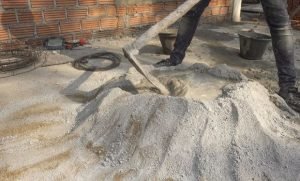Finding the Right Consistency of Tile Adhesive: The Key to Strong and Lasting Tiles
Learn how to mix tile adhesive to the right consistency for smooth application and strong bonding. Discover easy tips to avoid sliding tiles, hollow spots, and weak adhesion for perfect tiling results.


 The water-cement ratio: The water-cement quotient is an essential parameter for designing the concrete. Its change affects the content of freezable water content in the concrete, the average air bubble distance and the strength of concrete, thereby affecting the frost resistance of concrete. The larger the water-cement ratio, the more freezable water content in the concrete, and the faster the freezing speed of the concrete; The worse the bubble structure, the larger the average bubble distance; The lower the concrete strength, the worse the resistance to freezing and thawing. The addition of superplasticizer can reduce the water-cement ratio and reduce the amount of water that can be frozen, which can reduce the pressure caused by the freezing of water into ice;
The water-cement ratio: The water-cement quotient is an essential parameter for designing the concrete. Its change affects the content of freezable water content in the concrete, the average air bubble distance and the strength of concrete, thereby affecting the frost resistance of concrete. The larger the water-cement ratio, the more freezable water content in the concrete, and the faster the freezing speed of the concrete; The worse the bubble structure, the larger the average bubble distance; The lower the concrete strength, the worse the resistance to freezing and thawing. The addition of superplasticizer can reduce the water-cement ratio and reduce the amount of water that can be frozen, which can reduce the pressure caused by the freezing of water into ice; The nature of the raw materials forming the concrete affects the frost resistance of the concrete directly. For example, from 70% to 93% of the total concrete raw materials are stones and sand, the quality of these primary raw materials is directly influencing the frost resistance of the concrete. The quality of these primary raw materials mainly includes the degree of weathering, firmness, impurity content, clay content and the like. Besides the quality as mentioned earlier, the moisture absorption and permeability of these primary raw materials also have an impact on the frost resistance of the concrete. This phenomenon occurs mainly because the change in the moisture and strength of the primary raw materials inside the concrete vary the volume of the needle-shaped rock. This volume deviation will damage the hardened cement mortar and the concrete surface.
The nature of the raw materials forming the concrete affects the frost resistance of the concrete directly. For example, from 70% to 93% of the total concrete raw materials are stones and sand, the quality of these primary raw materials is directly influencing the frost resistance of the concrete. The quality of these primary raw materials mainly includes the degree of weathering, firmness, impurity content, clay content and the like. Besides the quality as mentioned earlier, the moisture absorption and permeability of these primary raw materials also have an impact on the frost resistance of the concrete. This phenomenon occurs mainly because the change in the moisture and strength of the primary raw materials inside the concrete vary the volume of the needle-shaped rock. This volume deviation will damage the hardened cement mortar and the concrete surface.




